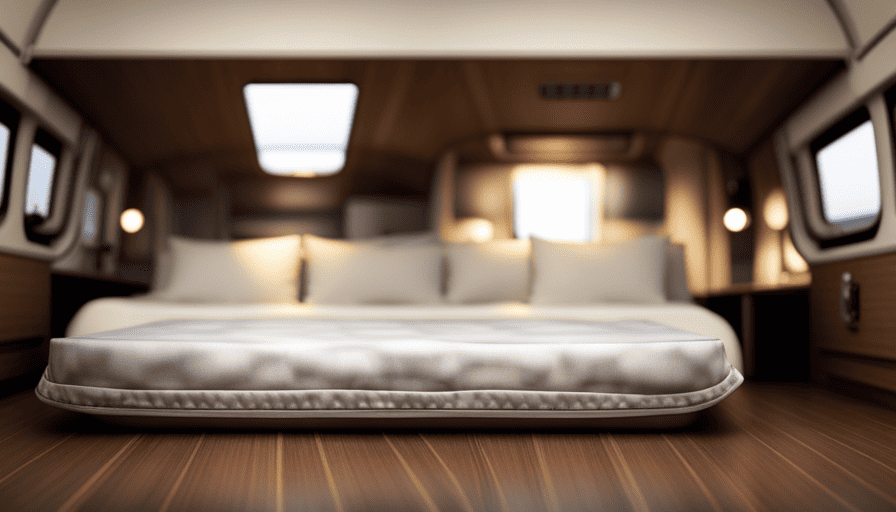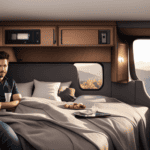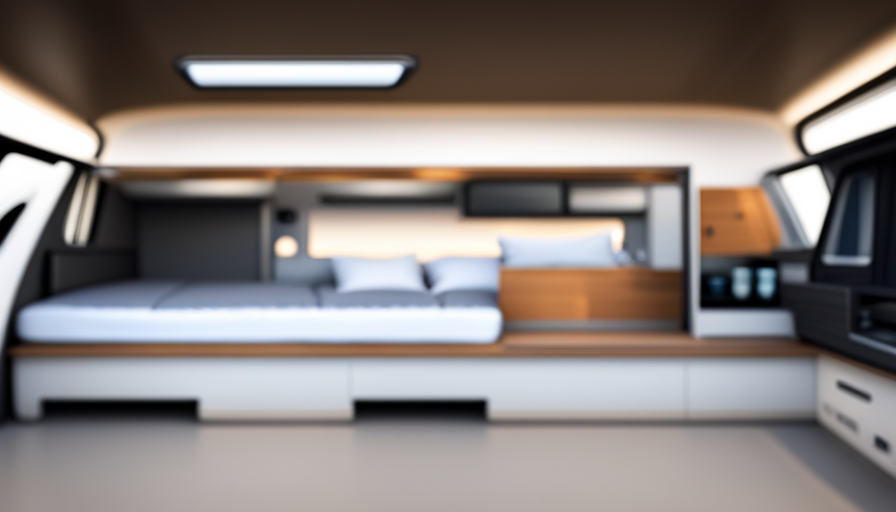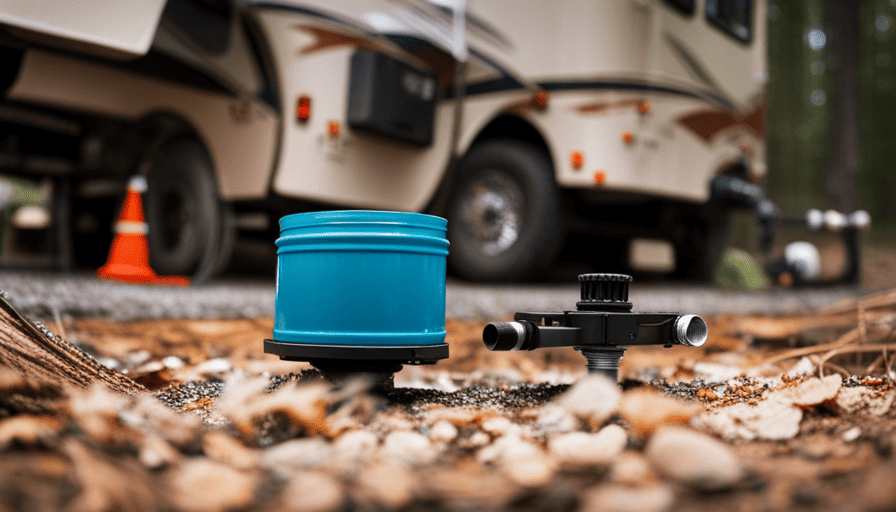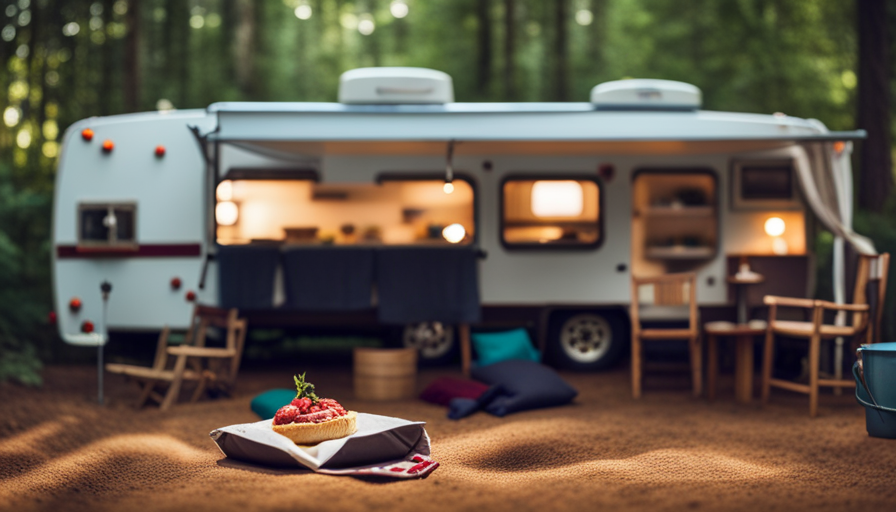So, you own a transit van and are prepared to start a fresh journey. However, why stick with a standard van when you have the option to convert it into a personalized camper? By applying a touch of inventiveness and utilizing your DIY abilities, you can metamorphose your van into a snug and inviting rolling home.
In this article, I’ll guide you through the process of converting a transit van into a camper. We’ll cover everything from assessing your needs and budget to planning your layout and design. I’ll share tips on insulation, electrical and plumbing systems, and creating comfortable living spaces. We’ll also discuss essential appliances and fixtures, as well as how to personalize your camper with decor and accessories.
By the end of this article, you’ll have all the knowledge and practical steps you need to transform your transit van into the perfect camper for your next adventure. First, you’ll need to empty out the interior of your transit van and decide on the layout that will work best for your needs. Then, it’s time to invest in some essential camper van conversion items such as a bed platform, storage solutions, and a kitchenette. If you are looking to convert minivan into camper, it will require a similar process of removing the seats, designing a layout, and installing the necessary components to make it a comfortable and functional living space for your travels. Next, you’ll want to consider installing insulation, lighting, and ventilation to make your camper van a cozy and comfortable place to spend time in. Don’t forget to also think about the electrical setup and plumbing needs for your camper van. Once your van is fully equipped, you’ll be ready to hit the road and embark on exciting new adventures. For those looking for trailer conversion tips, there are plenty of resources available online to guide you through the process of turning a trailer into a functional living space. With the right tools and knowledge, you’ll be well on your way to creating the perfect mobile home for your future travels.
So let’s get started and turn your van into your dream home on wheels!
Key Takeaways
- Budget planning is crucial for affording materials and modifications for the conversion.
- Assessing needs helps determine the features and amenities needed in the camper.
- Layout and design considerations include bed placement, storage solutions, kitchen layout, bathroom options, and seating arrangements.
- Gathering necessary tools and materials before starting the conversion process is essential.
Assess Your Needs and Budget
You’ll want to take a good look at what you need and how much you can spend before diving into the exciting project of turning your transit van into a cozy camper. Budget planning is crucial in ensuring that you can afford all the necessary materials and modifications for your van conversion. Start by setting a realistic budget and stick to it throughout the process.
Consider how much you are willing to invest in the van itself, as well as additional costs such as insulation, electrical systems, and furniture.
Next, conduct a thorough needs assessment to determine the features and amenities you want in your camper. Consider factors such as the number of people who will be using the van, the length of your trips, and the specific activities you plan to engage in during your travels. This will help you determine the layout and design that will best suit your needs.
Once you have completed the budget planning and needs assessment, you can move on to the next step of planning your layout and design. This involves determining the placement of essential components such as the bed, kitchenette, storage, and bathroom (if desired). By carefully considering your needs and budget, you can create a well-thought-out plan for your camper conversion that maximizes both functionality and comfort.
Plan Your Layout and Design
Start by envisioning the ideal arrangement and crafting a blueprint for your ultimate road-tripping sanctuary. Designing the layout of your camper conversion is crucial for maximizing space optimization and ensuring that every inch of your transit van is utilized efficiently. Consider your needs and preferences, such as whether you want a fixed bed or a convertible seating area, a kitchenette, or a bathroom. Think about the number of occupants and the activities you plan to engage in during your travels.
To help you visualize your design, I’ve created a table below that highlights some key design considerations and space optimization ideas:
| Design Considerations | Space Optimization |
|---|---|
| Bed placement | Foldable furniture |
| Storage solutions | Hidden compartments |
| Kitchen layout | Compact appliances |
| Bathroom options | Portable toilet |
| Seating arrangements | Collapsible tables |
By carefully considering these design elements, you can create a functional and comfortable living space within your van. Once you have a clear vision of your layout and design, you can move on to gathering the necessary tools and materials to bring your camper conversion to life.
Now, let’s transition into the next section where we will discuss how to gather the necessary tools and materials for your van conversion.
Gather the Necessary Tools and Materials
Get ready to embark on your road-tripping adventure by gathering all the essential tools and materials needed to transform your ordinary vehicle into a cozy and practical haven on wheels.
Before diving into the conversion process, it’s important to assess the costs associated with your project. Research the prices of the tools and materials you’ll need, such as power tools, insulation, flooring, cabinets, and appliances. This will give you a clear idea of your budget and help you plan accordingly.
Next, plan the layout of your camper van. Consider your specific needs and preferences. Do you need a kitchenette, a bed, or storage space? Sketch out a rough design and make a list of the materials you’ll need to bring your vision to life. Some common materials include plywood, screws, insulation foam, and adhesive.
Once you have a clear understanding of the costs and layout plan, it’s time to start gathering the necessary tools and materials. Visit your local hardware store or search online for the best deals. Look for high-quality tools that will make the conversion process easier and ensure a professional finish.
With all the tools and materials at hand, you’ll be ready to move on to the next step of insulating your van for comfort. This crucial step will ensure that your camper van remains cozy in all weather conditions.
Insulate Your Van for Comfort
Once you’ve gathered all the necessary tools and materials, creating a cozy and comfortable environment in your van becomes a priority, and insulating it will transform it into a haven that shields you from the elements.
To achieve optimal insulation, you’ll need to choose the right insulation materials and employ effective insulation techniques. Here are three key items to consider:
-
Insulation Materials: There are various insulation materials available in the market, each with its own advantages and disadvantages. Common options include polyurethane foam, mineral wool, and reflective insulation. Polyurethane foam offers excellent thermal performance and is easy to install. Mineral wool provides good soundproofing and fire resistance. Reflective insulation is ideal for reducing heat transfer and can be applied to walls, floors, and ceilings.
-
Insulation Techniques: Proper installation is crucial for achieving maximum insulation effectiveness. Ensure you cover all exposed surfaces, including the walls, floor, and ceiling. Use adhesive or fasteners to secure the insulation in place, and seal any gaps or joints with weatherstripping or caulk to prevent air leakage. Pay special attention to windows and doors, as they’re common areas for heat loss.
-
Additional Considerations: Don’t forget to insulate the wheel wells and engine compartment to minimize noise and temperature transfer. It’s also recommended to install a vapor barrier to prevent condensation and moisture buildup within the insulation.
Insulating your van is a vital step in creating a comfortable living space. Once you’ve successfully insulated your van, you can move on to the next phase of the conversion process: installing electrical and plumbing systems.
Install Electrical and Plumbing Systems
To create a fully functional and convenient living space, you’ll need to tackle the task of installing electrical and plumbing systems in your van. When it comes to choosing efficient electrical systems, it’s important to consider your power needs and the available space in your van.
Solar panels are a popular option for off-grid power, as they’re eco-friendly and can provide a consistent source of energy. Additionally, installing a deep-cycle battery and an inverter will allow you to power your appliances and electronics when you’re not connected to an external power source.
Designing a practical plumbing layout is also crucial for a comfortable camper van. Start by installing a freshwater tank and a water pump to ensure a steady supply of water. To maximize space, consider using flexible PEX pipes instead of rigid copper pipes. Don’t forget to include a water heater for hot showers and a greywater tank to collect wastewater. It’s also a good idea to install a water filtration system to ensure clean and safe drinking water.
Now that you’ve tackled the electrical and plumbing systems, let’s move on to building functional storage solutions.
Build Functional Storage Solutions
After installing the electrical and plumbing systems in your transit van camper, it’s time to focus on creating functional storage solutions. This step is crucial to maximize the limited space available and ensure that everything has its place.
Here are some practical ideas to help you make the most of your storage space:
-
Utilize vertical space: Install shelves or hanging organizers on the walls to store items such as kitchen utensils, toiletries, and camping gear.
-
Build custom cabinets: Design and construct cabinets that fit perfectly into the available space. Use a combination of drawers and shelves to accommodate different items, from clothing to food supplies.
-
Install under-bed storage: Utilize the area beneath your bed by adding pull-out drawers or bins. This is an excellent spot to store bulky items like bedding or outdoor equipment.
-
Create multi-purpose furniture: Opt for furniture pieces that serve dual purposes, such as a bench with built-in storage or a bed frame with drawers underneath.
By implementing these functional storage ideas, you can efficiently organize your belongings and maximize the space inside your camper.
In the next section, we will explore how to create comfortable living spaces, ensuring that your van feels like a home away from home.
Create Comfortable Living Spaces
When it comes to creating comfortable living spaces in a transit van camper, two key areas that require attention are the sleeping area and the lounge space.
To build a cozy sleeping area, it’s important to prioritize comfort and functionality. This can be achieved by choosing a quality mattress or bed system that fits the dimensions of the van and provides adequate support.
Additionally, designing a relaxing lounge space involves maximizing the available space. This can be done by incorporating comfortable seating, storage solutions, and a layout that promotes relaxation and socialization.
Build a Cozy Sleeping Area
Creating a cozy sleeping area in your transit van is the key to transforming it into the ultimate camper. To ensure a restful night’s sleep, start by investing in cozy bedding that’ll keep you comfortable in any weather. Opt for a high-quality mattress that fits snugly in the van and add soft, breathable sheets and blankets for added warmth and comfort.
Next, focus on efficient use of space. Consider installing a fold-out bed or a convertible sofa that can double as seating during the day. This’ll maximize your living area while still providing a comfortable place to sleep at night. Additionally, utilize storage solutions such as under-bed compartments or overhead shelves to keep your sleeping area organized and clutter-free.
By creating a cozy and efficient sleeping area, you’ll have a comfortable retreat to recharge after a day of exploring. Now, let’s move on to designing a relaxing lounge space for those moments when you wanna kick back and unwind.
Design a Relaxing Lounge Space
To create the perfect oasis for relaxation, let’s focus on designing a cozy lounge space in your transit van that’ll make you feel like you’re in a luxurious retreat.
Start by selecting lounge furniture that’s both comfortable and space-saving. Opt for a compact sofa or a bench with storage underneath, allowing you to maximize the limited space. Consider adding a foldable table that can serve as a dining area or workspace when needed.
When it comes to lighting options, choose soft and warm lights to create a calming atmosphere. Install LED strip lights along the ceiling or under cabinets for a subtle, yet effective, glow. Don’t forget to include task lighting for reading or working.
Now that you’ve created a relaxing lounge area, let’s move on to the next step of adding essential appliances and fixtures, which’ll make your van truly functional for your camping adventures.
Add Essential Appliances and Fixtures
When converting a transit van into a camper, it’s important to choose the right appliances that suit your needs. This will ensure that you have all the necessary tools and equipment to make your van feel like a comfortable home on the road.
Additionally, installing a functional kitchenette is essential for preparing meals and enjoying a hot cup of coffee while on the go. By carefully selecting the right appliances and fixtures, you can create a cozy living space that meets all your needs during your travels.
Choose the Right Appliances for Your Needs
First things first, figure out which appliances will suit your needs best. Did you know that on average, a compact fridge for a camper van can hold up to 40 cans of soda? When choosing energy efficient appliances, keep in mind that they’ll help you save battery power and reduce your overall energy consumption.
It’s also important to compare different appliance brands for their durability and reliability on the road. Here are some options to consider:
- A portable stove with multiple burners for cooking meals.
- A microwave oven for quick and easy reheating.
- A compact dishwasher to save time on cleaning up.
- A compact washing machine for doing laundry on the go.
- A small air conditioner or heater for climate control.
By carefully selecting the right appliances, you can create a comfortable and functional living space in your camper van. Once you’ve chosen your appliances, it’s time to move on to the next step: installing a functional kitchenette.
Install a Functional Kitchenette
Now that you’ve chosen the right appliances, it’s time to create a practical and efficient kitchenette in your camper van. A functional kitchenette design is essential for maximizing the limited space available.
Start by considering space-saving kitchen appliances that are specifically designed for campervans. Compact and multipurpose appliances, such as a combination stove and sink, a mini-fridge, and a collapsible dining table, can help optimize your kitchen area.
Install cabinets and shelves to store cookware, utensils, and pantry items neatly. Utilize vertical space by hanging pots, pans, and cooking utensils. Consider using magnetic strips or hooks to keep everything organized and easily accessible.
Additionally, invest in collapsible or stackable kitchenware to save even more space. With a well-designed kitchenette, you can enjoy cooking and dining comfortably during your travels.
As you move on to personalize your camper with decor and accessories, remember to incorporate elements that reflect your style and make your van feel like home.
Personalize Your Camper with Decor and Accessories
Transform your transit van into a cozy home away from home by adding personalized decor and accessories. Making your camper reflect your personal style will create a warm and inviting atmosphere during your travels.
Here are some camper decor ideas and a camper accessories shopping guide to help you elevate your camper conversion:
-
Cushions and Throws: Add comfort and style with cozy cushions and throws in vibrant colors or patterns. They not only make your space feel more inviting but also serve as a way to express your personality.
-
Wall Art and Prints: Hang artwork or prints to bring life to your camper’s walls. Choose pieces that inspire you or remind you of your favorite places. It’s a great way to personalize your space and make it feel like your own.
-
Lighting: Install LED lights or fairy lights to create a cozy ambiance in the evenings. They not only add a touch of magic but also provide practical lighting for reading or cooking.
-
Rugs and Mats: Add warmth and texture to your camper with rugs and mats. They not only make the space feel homier but also serve as a practical way to keep dirt and debris at bay.
-
Organizational Accessories: Maximize storage space by incorporating organizational accessories such as hanging organizers, storage bins, and hooks. They help keep your camper tidy and make it easier to find and access your belongings.
By personalizing your camper with decor and accessories, you can create a space that reflects your style and makes you feel at home wherever you go. Once you’ve added those finishing touches, it’s time to test and fine-tune your camper conversion.
Test and Fine-Tune Your Camper Conversion
Once your cozy home on wheels is complete, it’s time to put your camper conversion to the test and fine-tune every detail for the ultimate travel experience. Testing and fine-tuning your camper conversion is crucial to ensure that everything functions properly and optimally. It allows you to identify any potential issues or areas for improvement before hitting the road.
To start, take your newly converted camper for a test drive. Pay attention to how it handles on the road, noting any unusual sounds or vibrations. Check that all the mechanical components, such as the brakes, lights, and suspension, are in good working order. This will ensure your safety and the safety of others while on your travels.
Next, it’s time to optimize the layout of your camper. Use a 3 column and 4 row table to make this process more organized and visually appealing. In the first column, list the different areas or elements of your camper, such as the kitchen, sleeping area, storage, and bathroom. In the second column, note any issues or challenges you encounter with each area. In the third column, brainstorm potential solutions or improvements.
For example:
| Area | Issues | Solutions |
|---|---|---|
| Kitchen | Limited counter space | Install a foldable countertop extension |
| Sleeping area | Uncomfortable mattress | Upgrade to a more supportive mattress |
| Storage | Lack of organization | Install additional storage shelves |
By systematically going through each area and addressing any issues, you can fine-tune your camper conversion to create a more functional and enjoyable living space. Don’t be afraid to make adjustments and modifications as necessary.
Lastly, consider taking your camper on a short camping trip to test it in real-life situations. This will give you a better understanding of how well it meets your needs and allows you to make any final tweaks or adjustments.
Testing and fine-tuning your camper conversion is an essential step to ensure a successful and enjoyable travel experience. By optimizing the layout and addressing any issues that arise, you can create the ultimate home on wheels for your adventures.
Frequently Asked Questions
Can I legally convert a transit van into a camper?
Legally converting a transit van into a camper is possible, but it requires meeting certain requirements.
To comply with legal standards, you’ll need to ensure that your van meets specific criteria like having a designated living space, cooking facilities, and a separate sleeping area.
Additionally, it’s crucial to inform your insurance provider about the modifications and obtain appropriate coverage for your camper van.
Understanding the legal requirements and securing insurance coverage will ensure a smooth and hassle-free conversion process.
How long does it typically take to convert a transit van into a camper?
On average, it takes about 2-3 months to convert a transit van into a camper. However, the conversion time can vary depending on factors like the complexity of the design and the amount of work needed.
To successfully complete the conversion, you’ll need a set of essential tools and equipment. These may include power tools, measuring tape, a jigsaw, a drill, screws, insulation materials, a propane stove, and a portable toilet.
Can I install solar panels on my camper van for off-grid power?
Absolutely! Installing solar panels on your camper van is a fantastic way to harness the power of the sun and find off-grid power sources. It’s a straightforward process that involves mounting the panels securely on the roof and connecting them to a battery bank.
By doing this, you’ll have a reliable and sustainable source of electricity for all your camping adventures. Plus, it’s a great way to reduce your carbon footprint and embrace a more eco-friendly lifestyle.
What are some common challenges or obstacles during the conversion process?
During the conversion process, there are several common challenges that you may encounter. One of the challenges is creating a well-designed layout that maximizes space efficiency while still providing comfort.
Another challenge is ensuring proper insulation and ventilation to regulate temperature inside the camper.
Additionally, sourcing and installing the necessary equipment, such as electrical systems and plumbing, can also pose challenges.
It’s important to plan ahead and research thoroughly to overcome these obstacles and successfully convert your van into a camper.
Are there any specific safety regulations or standards I should be aware of when converting a van into a camper?
Safety regulations and standards are crucial when converting a van into a camper. It’s essential to ensure the safety of yourself and others on the road.
Some important regulations to consider include electrical wiring standards, gas installation requirements, ventilation regulations, and fire safety measures.
Additionally, you should be aware of weight restrictions and load capacity limits to avoid overloading the vehicle.
Following these regulations will help you create a camper van that’s safe and reliable for your adventures.
What Are the Similarities Between Converting a Sprinter Van and a Transit Van Into a Camper?
When it comes to converting a sprinter van camper and a transit van into a camper, there are notable similarities. Both projects involve transforming these vehicles into comfortable living spaces on wheels, complete with essential amenities. Whether it’s maximizing storage, installing a bed, or equipping a kitchenette, the process of convert sprinter van camper and transit van camper requires careful planning, design, and execution to create a cozy and functional travel space.
Conclusion
After completing the conversion of my transit van into a camper, I couldn’t be happier with the results. The cozy living spaces, complete with comfortable seating and a functional kitchen, make me feel like I’m in a home away from home.
The insulation keeps me warm during chilly nights, and the electrical and plumbing systems provide all the modern conveniences I need.
As I drive down the open road, with the wind in my hair and the freedom of the open road ahead of me, I know that my converted camper is the perfect companion for my adventures.

